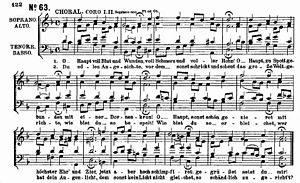
Jesu, meine Freude, BWV 227, is a motet by Johann Sebastian Bach. The longest and most musically complex of Bach's motets, it is set in eleven movements for up to five voices. It is named after the Lutheran hymn "Jesu, meine Freude" with words by Johann Franck, first published in 1653. The motet contains the six stanzas of the hymn in its odd-numbered movements. The hymn tune by Johann Crüger appears in all of these movements in different styles of chorale settings. The text of the motet's even-numbered movements is taken from the eighth chapter of the Epistle to the Romans, a passage that influenced key Lutheran teachings. The hymn, written in the first person with a focus on an emotional bond with Jesus, forms a contrasting expansion of the doctrinal biblical text. Bach set both texts alternating with and complementing each other, in a structure of symmetries on different layers.
Johann Sebastian Bach composed the church cantata Wär Gott nicht mit uns diese Zeit, BWV 14, in Leipzig in 1735 for the fourth Sunday after Epiphany and first performed it on 30 January 1735, a few weeks after his Christmas Oratorio. The cantata, in Bach's chorale cantata format, is based on Martin Luther's hymn "Wär Gott nicht mit uns diese Zeit". Its text paraphrases Psalm 124, focussing on the thought that the believers' life depends on God's help and is lost without it.

"Now thank we all our God" is a popular Christian hymn. Catherine Winkworth translated it from the German "Nun danket alle Gott", written c. 1636 by the Lutheran pastor Martin Rinkart. Its hymn tune, Zahn No. 5142, was published by Johann Crüger in the 1647 edition of his Praxis pietatis melica.
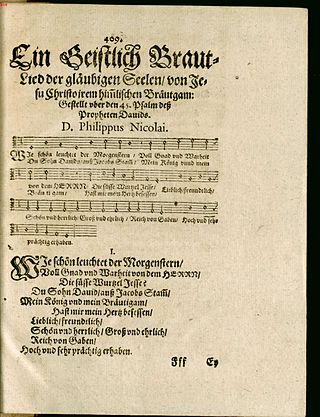
"Wie schön leuchtet der Morgenstern" is a Lutheran hymn by Philipp Nicolai written in 1597 and first published in 1599. It inspired musical settings through centuries, notably Bach's chorale cantata Wie schön leuchtet der Morgenstern, BWV 1, but also vocal and instrumental works by Baroque composers, Peter Cornelius, Felix Mendelssohn, Max Reger, Hugo Distler, Ernst Pepping, Mauricio Kagel and Naji Hakim.
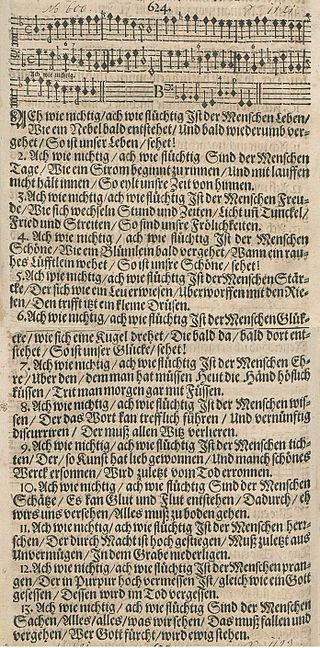
"Ach wie flüchtig, ach wie nichtig" is a German Lutheran hymn with lyrics by Michael Franck, who published it with his own melody and a four-part setting in 1652. Johann Crüger's reworked version of the hymn tune was published in 1661. Several Baroque composers used the hymn, including Johann Sebastian Bach, who wrote a chorale cantata. It is part of the current Protestant hymnal Evangelisches Gesangbuch, and has also been used by 20th-century composers such as Ernst Pepping and Mauricio Kagel.

"Nun komm, der Heiden Heiland" is a Lutheran chorale of 1524 with words written by Martin Luther, based on "Veni redemptor gentium" by Ambrose, and a melody, Zahn 1174, based on its plainchant. It was printed in the Erfurt Enchiridion of 1524.
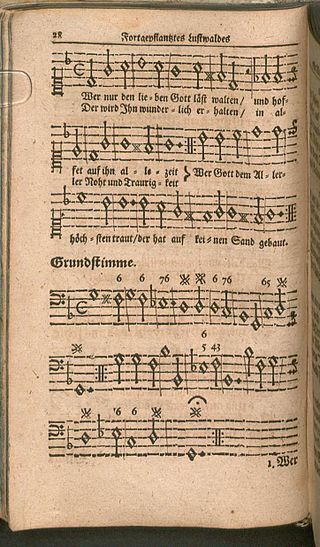
"Wer nur den lieben Gott läßt walten" is a 1641 hymn by Georg Neumark, who also composed the melody for it. It has seven verses and deals with the Christian putting their trust in God. Its author referred to it as a "Trostlied" or song of consolation and it first appeared in his Fortgepflantzer musikalisch-poetischer Lustwald. It also appeared in Johann Crüger's 1672 Praxis pietatis melica and in the first part of Johann Anastasius Freylinghausen's 1704 Geistreiches Gesangbuch. It has inspired musical settings, and is part of current German hymnals, both Protestant and Catholic.
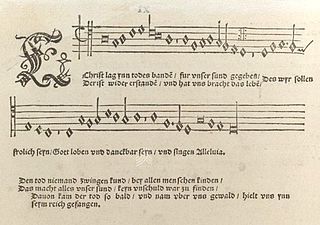
"Christ lag in Todesbanden" is an Easter hymn by Martin Luther. Its melody is by Luther and Johann Walter. Both the text and the melody were based on earlier examples. It was published in 1524 in the Erfurt Enchiridion and in Walter's choral hymnal Eyn geystlich Gesangk Buchleyn. Various composers, including Pachelbel, Bach and Telemann, have used the hymn in their compositions.
There are 52 chorale cantatas by Johann Sebastian Bach surviving in at least one complete version. Around 40 of these were composed during his second year as Thomaskantor in Leipzig, which started after Trinity Sunday 4 June 1724, and form the backbone of his chorale cantata cycle. The eldest known cantata by Bach, an early version of Christ lag in Todes Banden, BWV 4, presumably written in 1707, was a chorale cantata. The last chorale cantata he wrote in his second year in Leipzig was Wie schön leuchtet der Morgenstern, BWV 1, first performed on Palm Sunday, 25 March 1725. In the ten years after that he wrote at least a dozen further chorale cantatas and other cantatas that were added to his chorale cantata cycle.
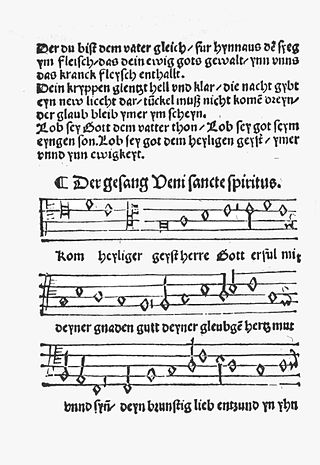
"Komm, Heiliger Geist, Herre Gott" is a Lutheran hymn for Pentecost, with words written by Martin Luther based on "Veni Sancte Spiritus, reple tuorum corda fidelium". The hymn in three stanzas was first published in 1524. For centuries the chorale has been the prominent hymn (Hauptlied) for Pentecost in German-speaking Lutheranism. Johann Sebastian Bach used it in several chorale preludes, cantatas and his motet Der Geist hilft unser Schwachheit auf, BWV 226.
"Vater unser im Himmelreich" is a Lutheran hymn in German by Martin Luther. He wrote the paraphrase of the Lord's Prayer in 1538, corresponding to his explanation of the prayer in his Kleiner Katechismus. He dedicated one stanza to each of the seven petitions and framed it with an opening and a closing stanza, each stanza in six lines. Luther revised the text several times, as extant manuscript show, concerned to clarify and improve it. He chose and possibly adapted an older anonymous melody, which was possibly associated with secular text, after he had first selected a different one. Other hymn versions of the Lord's Prayer from the 16th and 20th-century have adopted the same tune, known as "Vater unser" and "Old 112th".
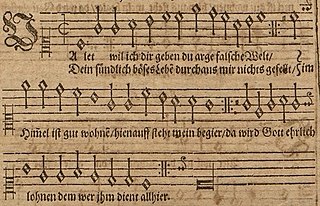
"Valet will ich dir geben" is a Lutheran hymn written by Valerius Herberger in 1613. It is a Sterbelied. The text was published with two hymn tunes by Melchior Teschner, Zahn Nos. 5403 and 5404a, in 1615. The second of these melodies was used in compositions such as chorale preludes by Johann Sebastian Bach and Max Reger. Bach used single stanzas in vocal works, including his St John Passion.

"Christ unser Herr zum Jordan kam" is a Lutheran hymn about baptism by Martin Luther, written in 1541 and published in 1543. It has been set in many musical compositions, including cantatas and chorale preludes by Johann Sebastian Bach.

"Heut triumphieret Gottes Sohn" is a Lutheran hymn for Easter. Kaspar Stolzhagen published the hymn in 1592, and its setting by Bartholomäus Gesius was published in 1601. The hymn was adopted in several hymnals, including the Evangelisches Gesangbuch. Composers such as Johann Sebastian Bach based compositions on its hymn tune.
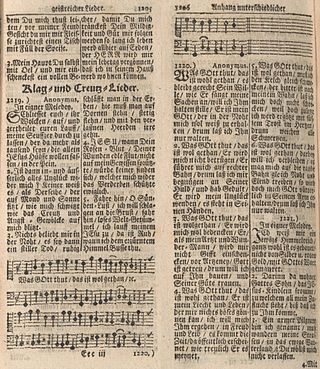
"Was Gott tut, das ist wohlgetan" is a Lutheran hymn written by the pietist German poet and schoolmaster Samuel Rodigast in 1675. The melody has been attributed to the cantor Severus Gastorius. An earlier hymn with the same title was written in the first half of the seventeenth century by the theologian Michael Altenburg.
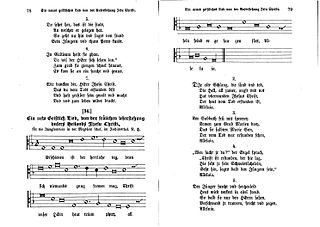
"Erschienen ist der herrlich Tag" is a German Easter hymn, with text and tune written by Nikolaus Herman and published in 1561. It has inspired musical settings by composers from the 17th to the 20th century. It appears in several hymnals, including the German Protestant hymnal Evangelisches Gesangbuch. Other hymns, especially Easter hymns, in both German and English, are sung to the same melody.

"Meinen Jesum laß ich nicht" is a German Lutheran hymn, with lyrics by Christian Keimann written in 1658. The theme of the hymn is trust in Jesus, based on memorial sermons for John George I, Elector of Saxony recalling conversations of the elector with his minister on his deathbed.

"Christus, der uns selig macht" is a German Lutheran Passion hymn in eight stanzas in German by Michael Weiße, written in 1531 as a translation of the Latin hymn "Patris Sapientia" to an older melody of the Bohemian Brethren.

"Liebster Gott, wann werd ich sterben" is a Lutheran hymn which Caspar Neumann, an evangelical theologian from Breslau, wrote around 1690. The topic of the hymn, which has five stanzas of eight lines, is a reflection on death. An elaborate analysis of the hymn's content was published in 1749. A few text variants of the hymn originated in the 18th century. Neumann's text is usually sung to the hymn tune of "Freu dich sehr o meine Seele".
